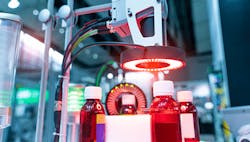If 2020 showed North America anything, it is that our supply chain for various products needs to be addressed. This means, in a lot of cases, manufacturing must be brought back to the mother ship.
I am in Canada, and it was and still is very pronounced due to the fact that we as a country do not have any vaccine-production facilities. This is being rectified by building two plants to manufacture vaccines for our future issues that are sure to be present in our lifetime.
A big problem with bringing this manufacturing onshore is the cost of the final product. People in North America are paid way more than their counterparts in offshore locations, generally speaking.
In order to remain competitive in the marketplace, people need co-inhabitants such as robots and vision systems.
Getting back to vaccine production, it is also imperative to have 100% inspection of the bottles before filling. The same could be said of the beverage industry. So, how do they do that? Vision.
The speeds at which product is made requires the use of high-speed cameras to do the inspection that a human cannot do at the speeds required.
This inspection is needed at the points of defect, which can be varied and would be needed in multiple places to reduce waste, as well as detect production issues that can crop up at any time.
While I am unfamiliar with the actual cost of making a vaccine dose, and we need to have as many 100% good quality vaccines as possible, this cannot be done with the use of vision systems.
A vision system characterized by a 360° inspection profile for vaccine bottles can utilize one camera per location and detect multiple deficiencies.
Vision systems—simple and complex—have been used for ages in the field of automation. Bottle inspection in the beverage industry has been employed forever. The future was very bright 20 years ago and has only gotten better as the years past.
What does the future hold now?
According to the industry, vision-system trends can be summarized in five areas.
- 3D vision (imaging) is gaining a lot of traction in the packaging industry in general but specifically in applications where 2D imaging is not efficient. Depth-of-field detection can be very valuable depending on the application. With the advent of cobots, depth-of-field detection will become more important due to social distancing issues that may stick around for a while due to COVID-19.
- Advances in sensor technology have allowed shortwave infrared (SWIR) line cameras to penetrate industries such as medical imaging and material sensing applications. One application would be the detection of non-visible (to the naked eye in visible light) features such as separation of Product A and Product B and of course detection of foreign parts that are not supposed to be there. The main component for success is contrast. SWIR cameras detect absorbed light instead of reflected light allowing it to be used in the discerning applications where the material composition needs to be consistent or detecting the percentage of difference between colors such as light and dark.
- One specification of camera speed is transmission of the result to the automation system. Back in the day, I used a vision system that interfaced with the PLC over serial. That bottleneck determined the throughput rate of product. Today, Ethernet-connected cameras can do well into the Gigabit range. There is a specification called CoaxPress 2.0, which is used for higher-speed camera applications for semiconductor inspection and other electronic applications.
- Edge vision systems may be coming to an application near you in the future. Field programmable gate arrays (FPGAs) and the camera’s ability to make its own automation decisions can drastically reduce processing time in a high-speed application. FPGAs provide this ability, and to have the camera as your automation partner in any application may prove more cost-effective than standard PC-based vision solutions.
- Vision-guided robots have been around for a while, but with COVID-19 there has been a growth spurt in order to reduce personal contact and social distancing. Cobots can be used to pick parts from trays, but how about from a rotary feeder? The robot’s vision system would have to align the end effector in order to pick up the part in its correct orientation to hand to its human counterpart. Expect to see more vision-guided robots as we move forward.
Vision systems have become much more intelligent since I started using them in the 1980s. They’re also much faster. It is a technology arena that requires your attention.
Jeremy Pollard, CET, has been writing about technology and software issues for many years. Pollard has been involved in control system programming and training for more than 25 years.
About the Author

Jeremy Pollard
CET
Jeremy Pollard, CET, has been writing about technology and software issues for many years. Pollard has been involved in control system programming and training for more than 25 years.

Leaders relevant to this article:

